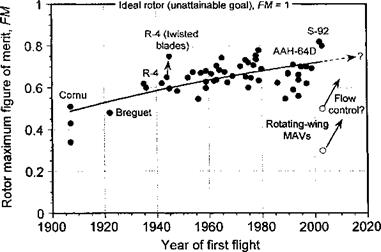Design of the Main Rotor
Arguably, the main rotor is the single most important component of the helicopter. Good overviews of the design of modem rotor systems are given by JanakiRam et al. (2003) and Rauch & Quillien (2003). Proper design of the rotor is critical to meeting the performance specifications that have been laid down for the helicopter as a whole. The design of the tail rotor is similar to that of the main rotor, but because it has a different set of design constraints it will be discussed separately. There is still a great deal of activity in developing an improved understanding of helicopter rotor aerodynamics and in developing new and improved mathematical models that will more faithfully predict the flow physics and help design more aerodynamically efficient rotors of lighter weight. One should always bear in mind that small, systematic improvements in rotor efficiencies can potentially result in significant increases in the payload capability, maneuver margins, or the forward flight speeds of modem helicopters.
Rotor design efficiency is often measured by figure of merit (see Section 2.8), although its use as a comparative metric is restricted to rotors operated at the same equivalent disk loading. A historical record of measured main rotor figure of merit versus year of initial development is shown in Fig. 6.2, the data (in part) being compiled by Carlson (2002). It is clear that improvements in aerodynamic design have lead to state-of-the-art values of FM approaching 0.82. While substantial gains have been obtained over the years, the slow asymptotic nature of the faired curve suggests that further increases in the FM of helicopter rotors may require much more revolutionary developments in its aerodynamic performance. Potentially, this can be obtained through better integrated aerodynamic optimization of the rotor, such with the use of fully 3-D aerodynamic design techniques combined (perhaps) with the use of forms of active flow control (see page 401). It would seem that values of FM approaching 0.85 may be feasible, although much work remains before such goals are realizable. The current interest in hovering small remotely piloted helicopters and micro air vehicles (see Section 6.14) suggests that at this scale the rotors may have FM values that are close to half of those obtained with full-scale rotors, and clearly there is considerable opportunity for improvement here.
|
Figure 6.2 Main rotor figure of merit versus year of development show sustained improvements in aerodynamic efficiency, although future gains may be more elusive. |
The conceptual and preliminary design of the main rotor must encompass the following key aerodynamic considerations:
1. General sizing: This will include a determination of rotor diameter, disk loading and rotor tip speed. There are several important trade-offs in performance and other characteristics with variations in all of these parameters.
2. Blade planform: This will include chord, solidity, number of blades, and blade twist. The optimal blade planform and twist distribution for hover may not be optimum for high-speed forward flight. The consideration of other than a rectangular tip shape may be part of the preliminary design.
3. Airfoil section(s): These play an important role in meeting overall performance requirements. On most modem rotors, the use of different airfoils at various stations along the blade will be a likely design choice to maximize rotor performance.












